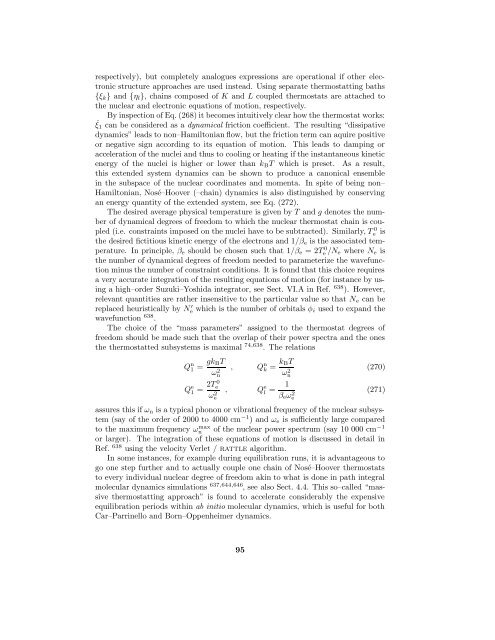Ab initio molecular dynamics: Theory and Implementation
Ab initio molecular dynamics: Theory and Implementation
Ab initio molecular dynamics: Theory and Implementation
- No tags were found...
You also want an ePaper? Increase the reach of your titles
YUMPU automatically turns print PDFs into web optimized ePapers that Google loves.
espectively), but completely analogues expressions are operational if other electronicstructure approaches are used instead. Using separate thermostatting baths{ξ k } <strong>and</strong> {η l }, chains composed of K <strong>and</strong> L coupled thermostats are attached tothe nuclear <strong>and</strong> electronic equations of motion, respectively.By inspection of Eq. (268) it becomes intuitively clear how the thermostat works:ξ˙1 can be considered as a dynamical friction coefficient. The resulting “dissipative<strong>dynamics</strong>” leads to non–Hamiltonian flow, but the friction term can aquire positiveor negative sign according to its equation of motion. This leads to damping oracceleration of the nuclei <strong>and</strong> thus to cooling or heating if the instantaneous kineticenergy of the nuclei is higher or lower than k B T which is preset. As a result,this extended system <strong>dynamics</strong> can be shown to produce a canonical ensemblein the subspace of the nuclear coordinates <strong>and</strong> momenta. In spite of being non–Hamiltonian, Nosé–Hoover (–chain) <strong>dynamics</strong> is also distinguished by conservingan energy quantity of the extended system, see Eq. (272).The desired average physical temperature is given by T <strong>and</strong> g denotes the numberof dynamical degrees of freedom to which the nuclear thermostat chain is coupled(i.e. constraints imposed on the nuclei have to be subtracted). Similarly, Te 0 isthe desired fictitious kinetic energy of the electrons <strong>and</strong> 1/β e is the associated temperature.In principle, β e should be chosen such that 1/β e = 2Te 0 /N e where N e isthe number of dynamical degrees of freedom needed to parameterize the wavefunctionminus the number of constraint conditions. It is found that this choice requiresa very accurate integration of the resulting equations of motion (for instance by usinga high–order Suzuki–Yoshida integrator, see Sect. VI.A in Ref. 638 ). However,relevant quantities are rather insensitive to the particular value so that N e can bereplaced heuristically by N e ′ which is the number of orbitals φ i used to exp<strong>and</strong> thewavefunction 638 .The choice of the “mass parameters” assigned to the thermostat degrees offreedom should be made such that the overlap of their power spectra <strong>and</strong> the onesthe thermostatted subsystems is maximal 74,638 . The relationsQ n 1 = gk BTω 2 nQ e 1 = 2T 0 eω 2 e, Q n k = k BTω 2 n, Q e l = 1β e ω 2 e(270)(271)assures this if ω n is a typical phonon or vibrational frequency of the nuclear subsystem(say of the order of 2000 to 4000 cm −1 ) <strong>and</strong> ω e is sufficiently large comparedto the maximum frequency ωnmax of the nuclear power spectrum (say 10 000 cm −1or larger). The integration of these equations of motion is discussed in detail inRef. 638 using the velocity Verlet / rattle algorithm.In some instances, for example during equilibration runs, it is advantageous togo one step further <strong>and</strong> to actually couple one chain of Nosé–Hoover thermostatsto every individual nuclear degree of freedom akin to what is done in path integral<strong>molecular</strong> <strong>dynamics</strong> simulations 637,644,646 , see also Sect. 4.4. This so–called “massivethermostatting approach” is found to accelerate considerably the expensiveequilibration periods within ab <strong>initio</strong> <strong>molecular</strong> <strong>dynamics</strong>, which is useful for bothCar–Parrinello <strong>and</strong> Born–Oppenheimer <strong>dynamics</strong>.95









